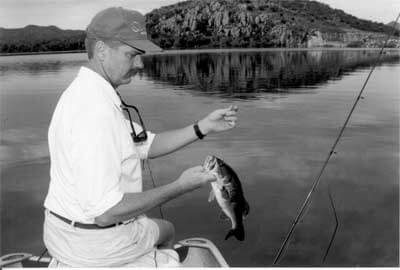 Arivaca Lake Is Rarely Crowded Arivaca Lake Is Rarely Crowded
By Margie Anderson
Arivaca Lake, nestled in a hollow surrounded by some of the
most beautiful high desert in the state, is rarely crowded.
At an
elevation of 3,750 feet, the shores of Arivaca are solid with big
trees and shrubs that insects love, so if you go there in the
summer, you had better remember your bug repellant and sunscreen.
Arivaca averages about 80 acres in size. The lake is usually
very low in the summer, and even the rains during July of this
year did almost nothing to improve the situation.
Launching a small boat (think car-topper) is still possible,
but you need a four wheel drive to get to shore, so a boat that
can be dragged or carried to the water is your best bet.
Boat motors are limited to a single electric motor only, but
thatís ample for this small lake. Also, make sure you park your
vehicle up in the designated parking lot or you risk a ticket.
The weeds at Arivaca are thick and getting thicker, which can
make fishing from shore difficult. For bass, try fishing a
floating worm rigged weedless, or pull a topwater rat or frog over
the weeds.
Bass fishing is usually pretty good at Arivaca, but you must
let them go immediately. If you have launched a boat and are using
an electric motor, you might want to invest in a Shear Magic by
Mister Twister.
This is a blade that attaches to your trolling motor to keep
the weeds from getting it stuck. Right now at http://www.mepps.com/mistertwister/
they have them on sale for less than thirty dollars.
There are no developed camping sites at Arivaca, no water, and
no facilities except for toilets. You want to make sure you have
everything you need with you when you get there, unless you want
to drive the seven miles of dirt road back to the town of Arivaca.
There are plenty of open spots around the lake that you can
camp on, and all but the biggest RVs should be able to navigate
the roads in successfully. With a really big rig, I would call the
Coronado National Forest at (520)-281-2296 and inquire about road
conditions.
Because of high mercury levels in the warm-water fishes (bass,
sunfish, and catfish), the Game and Fish Department recommends
that you not eat these species. This means that Arivaca is
basically a catch-and-release lake, and because of this, there are
some huge bass and catfish in the lake.
The lake is only about 28 feet deep at the deepest point, so
the action is good all year long. In the summer and fall, topwater
lures are among the most popular baits for bass.
When the weeds are up, huge bass will lurk in water so shallow
that you can see their fins sticking out of the water. Throw a
plastic rat right up on shore then twitch it slowly across the
weeds with short, uneven jerks.
When the moss behind the lure starts to bulge, hang on!
Spook-type lures and chuggers work well in warm water too, if you
can find some weed-free areas to work them.
Snag Proof makes a bunch of weedless lures that Arivaca anglers
swear by. If you try something with dangling treble hooks, youíll
spend most of your time cursing and picking weeds out of the
hooks.
When the weeds are lower and there is some open water,
crankbaits and spinnerbaits work very well. Pitching a spinnerbait
or a jig up under an overhanging tree is almost a sure-fire way to
get a nice bass to bite.
We saw a couple of mosquito fish floating on the water, and
they look a lot like shad, so a crankbait in a shad pattern would
be my choice. In winter, jigs and Texas-rigged worms on points and
underwater structure are good producers.
There are a lot of good, healthy sunfish at Arivaca. Tiny jigs
or mealworms fished under a bobber were taking sunfish all along
the shoreline when we were there in August.
Arivaca has also produced enormous catfish, and the frog
population is unbelievable.
The shoreline at Arivaca varies from weedy mud banks to rip-rap
or bluffs. You can walk pretty much all around the lake on the
well-used paths that circle it, but again I warn you to make sure
you wear insect repellant; the mosquitoes and no-see-ums will eat
you alive if you donít.
With the lake so low, the paths may be quite a way from the
water, so be careful getting close. The mud can be sticky.
To get to the lake, take I-19 south and go west at the Arivaca
turn-off. Youíll pass through the town of Arivaca, then just
follow the signs.
The last few miles are dirt road. If it has been rainy, take
care. There are several washes that cross the road, and they can
get nasty if they have been running.
Keep an eye out and you might see white tails, mule deer,
javelina, and other wildlife. Arivaca is also right in the middle
of some of the best birding country in Arizona, so bring your
binoculars if you are a bird fancier.
For current information on fishing at Arivaca, contact the
Tucson office of the Arizona Game and Fish Department at (520)
628-5376. You can also check the weekly fishing report at
www.azgfd.gov. |
 September
2006
September
2006 September
2006
September
2006